 |
 |
 |
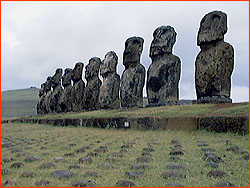 Past Attempts
Past Attemptsby Liesl Clark Rock, Roll, and Drag ROCK IT, standing up, side-to-side. Or, maybe try to ROLL IT, lying down, on round palm poles, or perhaps DRAG IT on its back. Among the many secrets buried in Easter Island prehistory is the question of how the Rapanui people transported the multi-ton statues, or moai, from their quarries to their final ceremonial ahu sites around the island. In many cases, the optimum route of transport would have meant that the teams of statue-movers, and the statues themselves, had to traverse several miles over very rough and hilly terrain. What would have been the best way to move Easter Island's stone giants, which weighed, on average, some 14 tons? The transport question has long been debated, and has been the subject of some experimentation by a growing arena of theorists. All have tried to approach the question as the early Rapa Nui people did, with the use of only stone, wood, rope, and human power. The following is a brief summary of those attempts. We encourage you to peruse them, and then send in your own theory on how the moai were moved. |

|
Oral Tradition (Various Dates) Like most oral traditions, Rapa Nui folklore has been passed down through the generations, and it is unknown whether the stories are based on historical fact. Most center on the mystical idea that the massive megaliths were moved using "mana," or divine power. Those who possessed mana were able to command the moai to walk to their designated places. Accounts of who actually possessed mana differ greatly. In 1919, Katherine Routledge, a British archaeologist who lived on Easter Island for a year, recorded in her journal: "There was a certain old woman who lived at the southern corner of the mountain and filled the position of cook to the image-makers. She was the most important person of the establishment, and moved the images by supernatural powers (mana), ordering them about at her will." Earlier accounts recorded by visitors to the island indicate that statues were ordered to walk by the mythical King Tuu Ku Ihu and the god Make Make. Even specialized priests were known to move moai at the request of those who wanted them on their family land or ahu. | |

|
Moai Transport Theories & Attempts Theorist: Thor Heyerdahl Date: 1955 - 1956 Location: Easter Island, Ahu Nau Nau - Anakena Moai: 13-foot, 10-ton original moai from Easter Island Method: Tied statue on its back to a sledge (sled) made from a tree fork. 180 islanders pulled the statue using two parallel ropes tied to each side. Recent tradition supports this theory, as sledge transportation was believed to have been enhanced by the use of lubricants such as sweet potatoes, palm fronds, and taro root. Limitations: Requires sizable work force. If it takes 180 people to move a 10-ton moai, it would take an estimated 1500 people to move the largest moai successfully erected on an ahu, Paro, which weighs 82 tons. | |
 
|
Theorist: William Mulloy Date: 1960 Location: Easter Island Moai: Theorized for Paro, the largest statue erected on an ahu (Ahu Te Pito Kura), standing approximately 32.45 feet tall and weighing 82 tons. Method:The process involved using two gigantic wooden "shear"or V-shaped legs, attached by ropes to the statue's neck, and a curved Y-shaped sledge to protect the moai's protruding belly. The moai lay face down on the sledge. Mulloy suggested that by inching the individual legs forward in bipedal fashion, the moai could then be rocked forward using the outward curve of its belly as a fulcrum or pivot point. By this method, Mulloy estimated that Paro could have been moved the four miles (six km) from the quarry to its ahu using only 90 people. Limitations: Overly complex: heavily reliant on the huge trees necessary to create gigantic shear legs and curved wooden forks for wooden sledges. In addition, given the dimensions of the moai, it is doubtful that the neck of the moai could absorb the excessive stress needed for this method. In addition, many statues found abandoned in transit did not have protruding stomachs substantial enough to act as a pivot point. | |

|
Theorist: Erich Von Daniken Date: 1972 Location: n/a Moai: n/a Method: By observing the mathematical perfection of the Egyptian Great Pyramids as well as the giant geoglyphs (pictures carved into stone) aligned perfectly through the Peruvian Andes, Von Daniken suggested that these great engineering feats could only be explained by the presence of extra-terrestrials years ago. Von Daniken suggested, "The men who could execute such perfect work must have possessed ultra-modern tools.... A small group of intelligent beings was stranded on Easter Island owing to a 'technical hitch.'The stranded group had a great store of knowledge, very advanced weapons and a method of working stone unknown to us.... Perhaps to leave the natives a lasting memory of their stay, but perhaps also as a sign to the friends who were looking for them, the strangers extracted a colossal statue from the volcanic stone. Then they made more stone giants which they set up on stone pedestals along the coast so that they were visible from afar.... In the remote past there were intelligences with an advanced technology for whom the covering of vast distances in aircraft of the most varied kinds was no problem." (Erich Von Daniken, Return to the Stars, 1972) Limitations:Purely hypothetical with no way to prove hypothesis | |
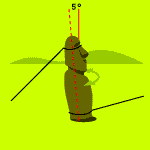
|
Theorist: Pavel Pavel Date: 1982 Location: Strakonice, Czechoslavakia Moai: 15-foot, 12-ton concrete replica with a slightly convex base Method: Interested in legendary lore that the moai walked, Pavel Pavel based his theory on the assumption that an upright moai was relatively stable; each statue has a low center of gravity thanks to a large base and a narrow head. Pavel Pavel used a crew of 17 people divided into two groups and tilted the statue onto its back edge (he calculated that five degrees was a safe tilt). With one rope around the head of the statue and another around the base, they "walked" the moai replica forward by swiveling and rocking it from side to side. Using this method, Pavel Pavel estimated that an experienced crew could move a statue approximately 650 feet each day. Limitations: Extremely problematic in rough terrain, and can damage the base of the moai. Thor Heyerdahl has estimated that the distance that can be covered using this method in rough terrain is 320 feet per day for a 20-ton statue. | |
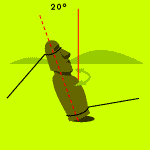
|
Theorist: Pavel Pavel, Thor Heyerdahl & Kon Tiki Museum Date: 1986 Location: Easter Island, site around the bay of Anakena Moai: Two original Easter Island moais: nine feet, five tons and 13 feet, nine tons. Method: Trying the same method as above on actual moai statues, Pavel Pavel used a crew of eight people for the nine-foot moai and a crew of 16 for the 13-foot moai. Using this method, the moai proved to be so stable that it could tilt 70 degrees to either side without falling. Limitations: The swiveling motion caused noticeable damage to the base of the moai and forced them to stop the experiment. | |
 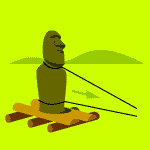
|
Theorist: Charles Love Date: 1980s Location: Wyoming Moai: 13-foot, 10-ton concrete replica Method: At first, Love's crew attempted to advance the standing concrete moai forward by pulling it, side to side, with ropes tied around its forehead like a refrigerator being "walked" forward. He was only able to move it a few hundred feet before the replica toppled over and the front of the base was chipped. On a second attempt, they placed the statue upright on two sled runners atop log rollers. Using this method, 25 men were able to move the statue 150 feet in two minutes. Limitations: Jo Anne Van Tilburg writes, "This method was superior to the tilting method, but still incredibly dangerous. The logistics of any upright method suggested to date are daunting-to-impossible on the rolling Rapa Nui terrain." | |
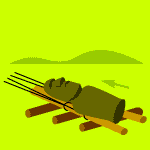
|
Theorist: Jo Anne Van Tilburg Date: 1998 proposed method Location: Easter Island Moai: Concrete replica with the dimensions of a statistically average moai Method: Van Tilburg is proposing to place the maoi replica horizontally, in either a prone or supine position, on a wooden sledge with rollers underneath. Guide and pulling ropes will be lashed to the sledge and up to 70 Rapanui people will attempt to haul it. This method will be used over a roadbed and up a slope, where the moai will be dropped to a 45 degree angle in preparation for erecting it in place. Limitations: To be determined. If you have a different idea for how the moai may have been moved, send it in. Past Attempts | Dispatches | The Plan | Team Profiles Move the Moai Game (get shockwave plug-in) | Your Theories Photos: Liesl Clark Move a Megalith | Dispatches | Explore the Island | Lost Civilization Resources | E-mail | Table of Contents | Easter Island Home Editor's Picks | Previous Sites | Join Us/E-mail | TV/Web Schedule About NOVA | Teachers | Site Map | Shop | Jobs | Search | To print PBS Online | NOVA Online | WGBH © | Updated November 2000 |
|